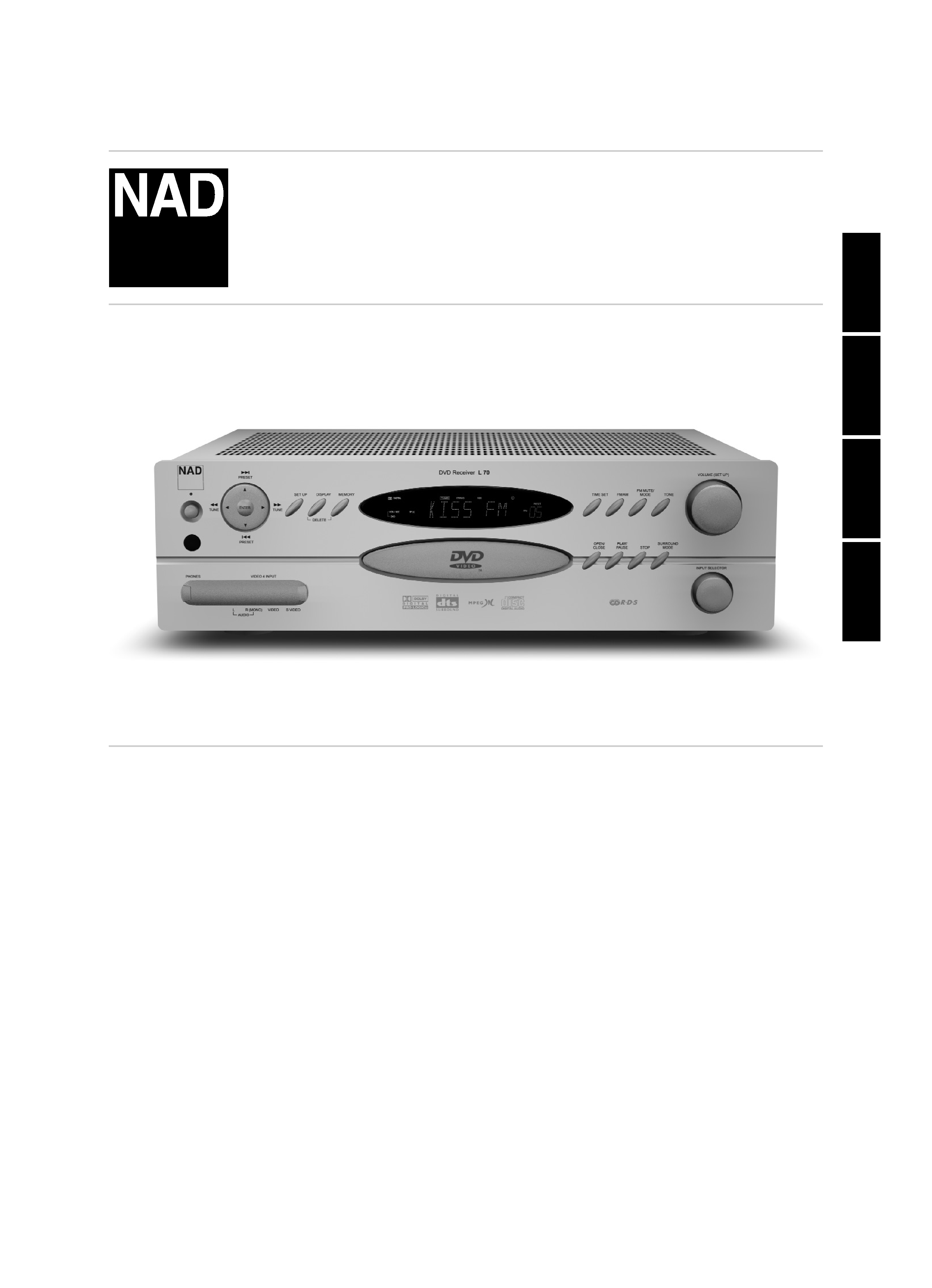
L70
DVD Receiver
ENGLISH
FRANÇAIS
DEUTSCH
NEDERLANDS
ESP
AÑOL
IT
ALIANO
POR
TUGUÊS
SVENSKA
Owner's Manual
Manuel d'Installation
Bedienungsanleitung
Gebruikershandleiding
Manual del Usuario
Manuale delle Istruzioni
Manual do Proprietário
Bruksanvisning
®
L70 IM english
13/3/05
4:33 pm
Page 1

2
WARNING: TO REDUCE THE RISK OF FIRE OR ELECTRIC SHOCK, DO NOT EXPOSE
THIS PRODUCT TO RAIN OR MOISTURE
CAUTION
THIS DVD PLAYER EMPLOYS A LASER SYSTEM. TO ENSURE PROPER USE OF THIS PRODUCT, PLEASE READ
THIS OWNER'S MANUAL CAREFULLY AND RETAIN FOR FUTURE REFERENCE. SHOULD THE UNIT REQUIRE
MAINTENANCE, CONTACT AN AUTHORISED SERVICE LOCATION.
USE OF CONTROLS, ADJUSTMENTS TO MODIFY PERFORMANCE OF PROCEDURES OTHER THAN THOSE
SPECIFIED MAY RESULT IN HAZARDOUS RADIATION EXPOSURE.
TO PREVENT DIRECT EXPOSURE TO LASER BEAM, DO NOT TRY TO OPEN THE ENCLOSURE. VISIBLE
LASER RADIATION EXISTS WHEN THE ENCLOSURE IS OPENED. DO NOT STARE INTO BEAM.
THE APPARATUS SHOULD NOT BE EXPOSED TO DRIPPING OR SPLASHING LIQUIDS. OBJECTS FILLED WITH
LIQUIDS, SUCH AS VASES, SHOULD NOT BE PLACED ON THE APPARATUS.
WARNING: CHANGES OR MODIFICATIONS NOT EXPRESSLY APPROVED BY THE
PARTY RESPONSIBLE FOR COMPLIANCE COULD VOID THE USER'S AUTHORITY TO
OPERATE THE EQUIPMENT.
NOTE
The L70 is not an auto voltage DVD receiver. Connect only to the prescribed AC outlet, i.e., 120V 60Hz
or 230V 50Hz.
RECORD YOUR MODEL NUMBER (NOW, WHILE YOU CAN SEE IT)
The model and serial number of your new DVD receiver are located on the back of the cabinet. For your
future convenience, we suggest that you record these numbers here:
MODEL NO.____________________________
SERIAL NO.____________________________
SAFETY PRECAUTIONS
Introduction
ENGLISH
FRANÇAIS
DEUTSCH
NEDERLANDS
ESP
AÑOL
IT
ALIANO
POR
TUGUÊS
SVENSKA
NAD is a trademark of NAD Electronics International, a division of Lenbrook Industries Limited
Copyright 2005, NAD Electronics International, a division of Lenbrook Industries Limited
L70 IM english
13/3/05
4:33 pm
Page 2

3
INTRODUCTION
Safety precautions . . . . . . . . . . . . . . . . . . . . . . . . . . . . . . . . . . . .2
Table of contents . . . . . . . . . . . . . . . . . . . . . . . . . . . . . . . . . . . . .3
Getting the most from the NAD L70 . . . . . . . . . . . . . . . . . . . .4-5
Unpacking and setup. . . . . . . . . . . . . . . . . . . . . . . . . . . . . . . . . 4
About the L70 . . . . . . . . . . . . . . . . . . . . . . . . . . . . . . . . . . . . . . 4
E.A.R.S. and Digital Surround . . . . . . . . . . . . . . . . . . . . . . . . . . . 4
Ease of Use . . . . . . . . . . . . . . . . . . . . . . . . . . . . . . . . . . . . . . . . 5
Upgradability . . . . . . . . . . . . . . . . . . . . . . . . . . . . . . . . . . . . . . . 5
About the HTR L70 System Remote Control . . . . . . . . . . . . . . . . 5
Quickstart . . . . . . . . . . . . . . . . . . . . . . . . . . . . . . . . . . . . . . . . . 5
IDENTIFICATION OF CONTROLS
Front Panel/Display Window . . . . . . . . . . . . . . . . . . . . . . . . . .6-7
Rear Panel . . . . . . . . . . . . . . . . . . . . . . . . . . . . . . . . . . . . . . . . .8-9
SETUP
Setting up the L70 . . . . . . . . . . . . . . . . . . . . . . . . . . . . . . . . .10-12
Getting Started . . . . . . . . . . . . . . . . . . . . . . . . . . . . . . . . . . . . 10
Dealing With Hum and Noise. . . . . . . . . . . . . . . . . . . . . . . . . . 10
About the on-screen displays (OSD) and front panel readout. . . 10
Displaying the OSD . . . . . . . . . . . . . . . . . . . . . . . . . . . . . . . . . 11
Navigating the OSD and Making Changes . . . . . . . . . . . . . . . . 11
Input Setup . . . . . . . . . . . . . . . . . . . . . . . . . . . . . . . . . . . . . . . 12
Speaker configuration . . . . . . . . . . . . . . . . . . . . . . . . . . . . .13-14
Surround mode . . . . . . . . . . . . . . . . . . . . . . . . . . . . . . . . . . . . 13
Level trim (Test) setup. . . . . . . . . . . . . . . . . . . . . . . . . . . . . . . . 13
Delay time . . . . . . . . . . . . . . . . . . . . . . . . . . . . . . . . . . . . . . . . 14
OPERATION
Using the L70 . . . . . . . . . . . . . . . . . . . . . . . . . . . . . . . . . . . . . . .15
Selecting Sources . . . . . . . . . . . . . . . . . . . . . . . . . . . . . . . . . . . 15
Adjusting the Volume . . . . . . . . . . . . . . . . . . . . . . . . . . . . . . . 15
Muting the Sound . . . . . . . . . . . . . . . . . . . . . . . . . . . . . . . . . . 15
Using the L70's DVD/VCD/CD . . . . . . . . . . . . . . . . . . . . . . . .16-18
About DVD/VCD/CD . . . . . . . . . . . . . . . . . . . . . . . . . . . . . . . . 16
Region management information. . . . . . . . . . . . . . . . . . . . . . . 16
OSD Navigation . . . . . . . . . . . . . . . . . . . . . . . . . . . . . . . . . . . . 17
Transport Control Keys. . . . . . . . . . . . . . . . . . . . . . . . . . . . . . . 18
Title and Menu Keys . . . . . . . . . . . . . . . . . . . . . . . . . . . . . . . . 18
Using the L70's AM/FM radio . . . . . . . . . . . . . . . . . . . . . . . .19-20
About Antennas . . . . . . . . . . . . . . . . . . . . . . . . . . . . . . . . . . . 19
Selecting the Radio . . . . . . . . . . . . . . . . . . . . . . . . . . . . . . . . . 19
Tuning Stations . . . . . . . . . . . . . . . . . . . . . . . . . . . . . . . . . . . . 19
Setting Radio Presets . . . . . . . . . . . . . . . . . . . . . . . . . . . . . . . . 19
Selecting Radio Presets. . . . . . . . . . . . . . . . . . . . . . . . . . . . . . . 19
Choosing the FM Mute / Mode . . . . . . . . . . . . . . . . . . . . . . . . 20
About RDS . . . . . . . . . . . . . . . . . . . . . . . . . . . . . . . . . . . . . . . 20
Viewing RDS Text. . . . . . . . . . . . . . . . . . . . . . . . . . . . . . . . . . . 20
Entering User Names . . . . . . . . . . . . . . . . . . . . . . . . . . . . . . . . 20
About the L70's Surround Modes . . . . . . . . . . . . . . . . . . . . .21-24
Selecting SURROUND MODEs . . . . . . . . . . . . . . . . . . . . . . . . . 22
Adjusting SURROUND MODEs . . . . . . . . . . . . . . . . . . . . . . . . . 23
Adjusting LEVEL TRIM "On the Fly" . . . . . . . . . . . . . . . . . . . . . 24
Adjusting the Tone Controls . . . . . . . . . . . . . . . . . . . . . . . . . . . 24
12V Trigger Out. . . . . . . . . . . . . . . . . . . . . . . . . . . . . . . . . . . . 24
Using the HTR L70 remote control . . . . . . . . . . . . . . . . . . . .25-30
Specifications. . . . . . . . . . . . . . . . . . . . . . . . . . . . . . . . . . . . . . 25
Controlling the L70 . . . . . . . . . . . . . . . . . . . . . . . . . . . . . . . . . 25
Learning Codes From Other Remotes . . . . . . . . . . . . . . . . . . . . 26
Punch-Through . . . . . . . . . . . . . . . . . . . . . . . . . . . . . . . . . . . . 26
Copy a Command From Another Key. . . . . . . . . . . . . . . . . . . . 27
Macro Commands . . . . . . . . . . . . . . . . . . . . . . . . . . . . . . . . . . 27
Recording Macros . . . . . . . . . . . . . . . . . . . . . . . . . . . . . . . . . . 27
Executing Macros. . . . . . . . . . . . . . . . . . . . . . . . . . . . . . . . . . . 28
Key-Illumination Timeout . . . . . . . . . . . . . . . . . . . . . . . . . . . . . 28
Factory Reset . . . . . . . . . . . . . . . . . . . . . . . . . . . . . . . . . . . . . . 28
Delete Mode . . . . . . . . . . . . . . . . . . . . . . . . . . . . . . . . . . . . . . 28
Loading Code-Libraries. . . . . . . . . . . . . . . . . . . . . . . . . . . . . . . 29
Summary of HTR L70 Modes . . . . . . . . . . . . . . . . . . . . . . . . . . 30
REFERENCE
Troubleshooting . . . . . . . . . . . . . . . . . . . . . . . . . . . . . . . . . . . . .31
Specifications . . . . . . . . . . . . . . . . . . . . . . . . . . . . . . . . . . . . . . .32
TABLE OF CONTENTS
Introduction
ENGLISH
FRANÇAIS
DEUTSCH
NEDERLANDS
ESP
AÑOL
IT
ALIANO
POR
TUGUÊS
SVENSKA
THANK YOU FOR CHOOSING NAD
The L70 A/V Surround Sound DVD Receiver is a technologically advanced and highly capable product-yet we have invested great effort in making it
simple and easy to use. The L70 delivers a range of genuinely useful options for surround sound and stereo listening alike, using powerful digital signal
processing and superbly accurate digital-audio circuitry. However, we have also been careful to ensure that the receiver is as musically transparent and
spatially accurate as possible, incorporating much of what we've learned from a quarter-century's experience designing audio and home-theatre
components. As with all our products, NAD's "Music First" design philosophy guided the L70's design, such that it can confidently promise you both
state-of-the-art surround home-theatre and audiophile-quality music listening for years to come.
We encourage you to take a few minutes now to read right through this manual. Investing a little time here at the outset might save you a good
deal of time later, and is by far the best way to ensure that you make the most of your investment in the NAD L70, and get the most from this
powerful and flexible home-theatre component.
One more thing: We urge you to register your L70 ownership on the NAD Worldwide Web site:
http://NADelectronics.com/w/Registration.html
For warranty information contact your local distributor.
L70 IM english
13/3/05
4:33 pm
Page 3

4
UNPACKING AND SETUP
WHAT'S IN THE BOX
Packed with your L70 receiver you will find:
· An AM loop antenna
· An FM ribbon-wire antenna with balun
· The HTR L70 remote control with 4 (four) AAA batteries
· This owner's manual
SAVE THE PACKAGING
Please save the box and all of the packaging in which your L70 arrived. Should you move or otherwise
need to transport your receiver, this is by far the safest container in which to do so. We've seen too many
otherwise perfect components damaged in transit for lack of a proper shipping carton, so please: Save
that box!
CHOOSING A LOCATION
Choose a location that is well ventilated (with at least several inches to both sides and behind), and that
will provide a clear line of sight, within 25 feet/8 meters, between the receiver's front panel and your
primary listening/viewing position-this will ensure reliable infrared remote control communications. The
L70 generates a modest amount of heat, but nothing that should trouble adjacent components. It is
perfectly possible to stack the L70 atop other components, but the reverse usually should be avoided.
Nonetheless, it is generally preferable that the L70 stands alone. It is especially important that sufficient
ventilation be provided; if you are contemplating locating the L70 within a cabinet or other furniture,
consult your NAD audio/video specialist for advice on providing adequate airflow.
ABOUT THE L70
Though the L70 is among the most technically sophisticated integrated A/V & DVD receivers, we worked
hard to make it one of the most musically transparent home-theatre components available as well; this is
what we mean by NAD's "Music First" design philosophy. Here are just a few examples:
· High-performance components used throughout the receiver's analog audio circuits maximize
quality from all sources, including multichannel analog sources such as DVD-Audio and SACD.
· The L70 incorporates a high quality DVD player with exceptional playability. The player has support
for DVD video and audio, VCD, SVCD with playback control (PBC), CD audio such as CD-RW as
well as MP3. As with all NAD DVD players, a set of convenient navigation buttons is provided on
the front panel. See "Front Panel Controls".
· Gold-surfaced connectors are employed throughout to ensure maximum signal integrity.
E.A.R.S. AND DIGITAL SURROUND
A key element of the L70's unique musical aptitude is NAD's proprietary Enhanced Ambience Recovery
System (EARS). In sharp contrast to many "ambience-synthesis" music-surround modes, EARS exploits the
L70's substantial DSP power to route the ambient content that is "encrypted" in virtually all natural-
acoustic recordings to the appropriate main, centre and surround speakers, without resorting to artificially
generated reflections or regeneration. EARS' natural ambience yields a subtle but exceptionally effective
surround mode that naturally enhances the spatial presentation in a fashion suitable for serious music
listening. Dolby ProLogic II Music, Movie and Emulation modes can also create enjoyable experiences from
2-channel sources.
On the digital side, the L70 combines extraordinarily high-speed DSP processing employing one of the
most advanced high-speed DSP "engines" available, with fully 24-bit, 96 kHz-sampling-capable D/A
converters for all channels. A single, high-precision master clock synchronises all digital circuits to eliminate
the timing errors ("jitter") that otherwise compromise sonics. The result is legitimately state-of-the-art
surround decoding from Dolby Digital and DTS sources, and 5.1-channel reproduction, with genuinely
superior sound quality in all modes.
GETTING THE MOST FROM THE NAD L70
Introduction
ENGLISH
FRANÇAIS
DEUTSCH
NEDERLANDS
ESP
AÑOL
IT
ALIANO
POR
TUGUÊS
SVENSKA
L70 IM english
13/3/05
4:33 pm
Page 4

5
EASE OF USE
Despite the effort NAD has invested in the L70 receiver's sonic performance, we expended no less in
making it powerfully easy to use. Its design is uniquely simple for so sophisticated a component, and the
HTR L70 universal remote control is equally understandable, as are the L70's own front-panel and on-
screen displays (OSD).
UPGRADABILITY
The L70 receiver permits flexible system growth via individually accessible 5.1 channel input for
connectivity to products with integrated surround decoders.
See "Rear Panel (5.1 CH. INPUT)".
ABOUT THE HTR L70 SYSTEM REMOTE CONTROL
Packed with your L70 is the NAD HTR L70 remote control, a full-system remote especially designed to be easy
to use and easy to understand. Be sure to read the section "Using the HTR L70 Remote Control," to familiarize
yourself with the remote's layout and operations before proceeding to setup your receiver.
Chances are, you will want to use your HTR L70 as your primary way to command your entire A/V system.
The HTR L70 can be employed to operate additional NAD or other-brand components such as a second
DVD/CD player, television, satellite/HDTV tuner, VCR, or virtually anything else that operates via standard
infrared remote control.
QUICKSTART
In case you simply cannot wait to experience the performance of your new NAD L70 DVD/Receiver, we
provide the following "Quickstart" instructions to get you underway. The steps below connect your L70
to a TV/monitor; be sure to read "Input Setup".
PLAY A DVD MOVIE
· Connect the L70's composite video or S-Video "MONITOR OUT" jack to your TV/monitor's
corresponding input.
· Depending on the selection above, switch the "OSD SELECTOR" switch to either S-Video or
Composite position (found on the back of the L70 beside the Composite Output "MONITOR" jack.
· Connect your left and right front speakers to the L70's "FRONT L and R" outputs, being sure to
connect red to red ("+") and black to black ("-"), with care to avoid stray wires or strands crossing
between terminals. (Connect centre and surround speakers as well, if you like). If your system includes
a powered subwoofer, connect the L70's "SUBWOOFER PRE-OUT" jack to its line input.
· Plug the AC mains plug into the AC; the LED on the front panel will be lit blue indicating the L70 is in
standby mode ready to accept commands from either the front panel power switch or the HTR L70 remote.
·To start playback of the DVD player; press the HTR L70 remote's "DVD" Device Selector key, and then
its transport key "Open/Close" to select the DVD, insert the media and press the transport
play
key to start playing. You should hear multichannel or stereo sound, and see an image on the
TV/monitor. (If one or the other fails to appear, you may need to use either the L70's Receiver or DVD
on-screen menu systems to check assignment of audio and video inputs; see "Input Setup".)
Enjoy the movie or music, but be sure to set aside time to read this manual thoroughly, and to set up,
calibrate, and configure your L70 carefully and completely.
GETTING THE MOST FROM THE NAD L70
Introduction
ENGLISH
FRANÇAIS
DEUTSCH
NEDERLANDS
ESP
AÑOL
IT
ALIANO
POR
TUGUÊS
SVENSKA
L70 IM english
13/3/05
4:33 pm
Page 5
